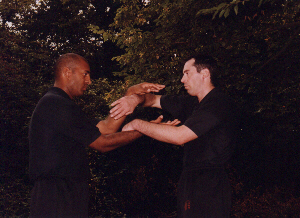Wing Chun Kung Fu is just one of many styles of martial arts whose origins are to be found in southern China and compared to other arts, is a relatively new style. Wing Chun is known as a 'soft' style, but is in fact a blend of both hard and soft techniques. This blending of hard and soft is due to the fact that it was developed by a woman and refined, in the main, by men. It is also said that the originator (a Buddhist nun named Ng Mui) observed a battle between a cobra snake and a crane bird. From her observations sprang ideas to develop this art. Mimicking animal movements is particularly common to Chinese martial arts and stems from their respect for nature.
Wing Chun is based on three principles, namely:
Simultaneous defence and counter attack
economy of motion in every technique
centre line
One of the most important techniques in Wing Chun is the practice of Sticky Hands (Chi Sau). Because Wing Chun is a close quarter system, it could be potentially dangerous to the practitioner themselves as they are usually in range of being hit, grabbed, kicked etc, by their opponent. This understanding has led to a remarkable skill training method called Sheung Chi Sau or Double Sticky Hands. This one technique how flexible the Wing Chun system is. It also shows that if one technique can be used in many situations why learn many different moves for many situations? This reinforces simplicity as a main tenant in the system Wing Chun is an art of self-defence where one is reacting to an initiated threat. This realistic approach is not a softer option as Wing Chun is a very effective counter striking style. Wing Chun is suitable for all ages and abilities with children as young as 5 years of age attending classes and developing well. People with various disabilities including the blind, paraplegic and persons with learning difficulties can all find Wing Chun adaptable and suitable. It is a clever, flexible system enabling most people to achieve a reasonable skill even in the face of adversity.

Wyszukiwarka
Podobne podstrony:
Wing Chun Kung Fu martial compared to other arts
BIOLOGIC PROPERTIES OF NANOCRYSTALLINE SILVER COMPARED TO OTHER SILVER PRODUCTS
Banking and commerce how does the United States compare to other countries
ebook Martial Arts The History and Philosophy of Wing Chun Kung Fu
(Ebook) Martial Arts Wing Chun Thetruth
Pressure Points Wing Chun History Dim Mak and Pressure Points (Martial Arts)
(ebook martial arts) Wing Chun Kung Fu Breathing NOTES ON MEDITATION AND HEALTH
(ebook) Martial Arts The History and Philosophy of Wing Chun Kung Fu 2
(ebook) Martial Arts The History and Philosophy of Wing Chun Kung Fu
Martial Arts Kung Fu Wing Chun Techniques Book Form
ebook Martial Arts The History and Philosophy of Wing Chun Kung Fu
Martial Arts Kung Fu Wing Chun Techniques Book Form
79 1111 1124 The Performance of Spray Formed Tool Steels in Comparison to Conventional
Kinesio taping compared to physical therapy modalities for the treatment of shoulder impingement syn
Chi Kung Wing Chun Kung Fu (2)
Animal?rm Compared to Russia's Communist Experience
Kung Fu Wing Chun Training
więcej podobnych podstron